2007 DODGE SPRINTER warning
[x] Cancel search: warningPage 35 of 393

34 SafetyOccupant safety
2
The driver’s front airbag and co-driver’s
front airbag are triggered:
\4in the initial stages of an accident with
a high rate of vehicle acceleration or
deceleration in a longitudinal direction
\4if the system determines that airbag
deployment can offer additional pro-
tection to that provided by the seat belt
\4independently of other airbags in the
vehicle
Thorax sidebags*
The purpose of the thorax/sidebags is to
increase the level of protection for the tho-
rax (but not the head, neck and arms) of
the occupants on the side of the vehicle on
which the impact occurs.
The thorax / sidebags are installed in the
outer sides of the backrests on the driver’s
seat and the co-driver’s individual seatWarning
G
For safety reasons, the manufacturer rec-
ommends that you use seat covers that
have been tested for Sprinter vehicles and
that have a seam for thorax / sidebags. A
thorax / sidebag may otherwise not inflate
correctly and could fail to provide the in-
tended degree of protection in the event of
a collision. You can obtain these covers from
an authorized Sprinter Dealer, for example.
Warning
G
To reduce the risk of injury to occupants if a
thorax / sidebag is triggered, make sure
that:
\4no persons, animals or objects are
present between the vehicle occupants
and the thorax / sidebag deployment
range
\4no accessories, for example cup hold-
ers, are secured to the doors
\4only light items of clothing are hung
from the coat hooks in the vehicle
\4there are no heavy or sharp objects in
the pockets of items of clothing
Warning
G
Observe the following to reduce the risk of
serious or fatal injury if the thorax / sidebag
is triggered:
\4Vehicle occupants – in particular, chil-
dren – must never lean their head
against the area of the window in which
the thorax / sidebag inflates.
\4Vehicle occupants must wear their seat
belt correctly at all times and lean back
against the backrest, which should be
positioned as upright as possible.
\4Always secure children who are less
than 5 ft (1.50 m) tall or under 12 years
of age in a suitable child restraint sys-
tem.
Page 36 of 393

35 Safety
Occupant safety
2
1Thorax sidebag
The thorax sidebags are triggered:
\4in the initial stages of an accident with
a high rate of vehicle acceleration or
deceleration in a lateral direction, for
example in the event of a side impact
\4on the side on which an impact occurs
\4if the system determines that airbag
deployment can offer additional pro-
tection to that provided by the seat belt
\4independently of the front airbagsIn the event of an accident, the thorax side-
bag next to the outer seat side inflates be-
tween the door and the chest area of the
occupant.
Windowbags*
The windowbags are designed to increase
protection to the head (but not to the chest
or arms) of the vehicle occupants on the
side on which the impact occurs.
The relevant windowbag is installed in the
side of the roof frame behind the trim pan-
el between the A and B-pillar.
iYou will find additional information
about airbag deployment on
(\2page 32).
You will find additional information
about the triggering of emergency ten-
sioning retractors and belt force limit-
ers on (\2page 30).Warning
G
To ensure that windowbags can provide the
intended degree of protection when de-
ployed, make sure that no persons, animals
or objects are present between the vehicle
occupants and the deployment range of the
windowbags.
Warning
G
Observe the following to reduce the risk of
serious or fatal injury if the windowbag is
triggered:
\4Vehicle occupants – in particular, chil-
dren – must never lean their head
against the area of the window in which
the windowbag inflates.
\4Vehicle occupants must wear their seat
belt correctly at all times.
\4Always secure children who are less
than 5 ft (1.50 m) tall or under 12 years
of age in a suitable child restraint sys-
tem.
Page 37 of 393
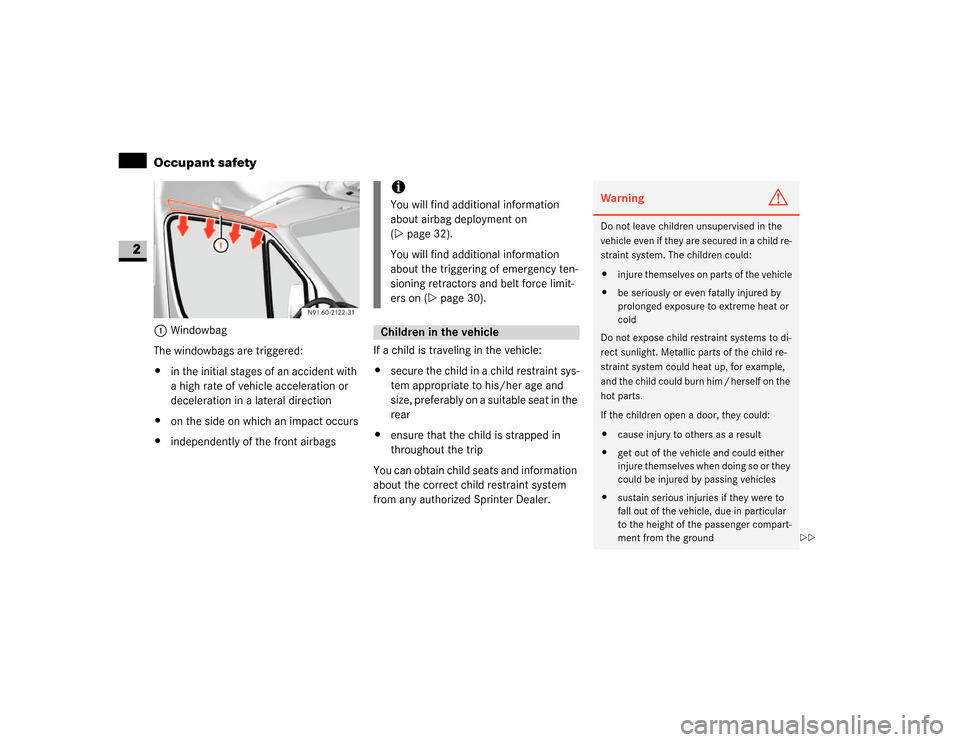
36 SafetyOccupant safety
2
1Windowbag
The windowbags are triggered:
\4in the initial stages of an accident with
a high rate of vehicle acceleration or
deceleration in a lateral direction
\4on the side on which an impact occurs
\4independently of the front airbagsIf a child is traveling in the vehicle:
\4secure the child in a child restraint sys-
tem appropriate to his/her age and
size, preferably on a suitable seat in the
rear
\4ensure that the child is strapped in
throughout the trip
You can obtain child seats and information
about the correct child restraint system
from any authorized Sprinter Dealer.
iYou will find additional information
about airbag deployment on
(\2page 32).
You will find additional information
about the triggering of emergency ten-
sioning retractors and belt force limit-
ers on (\2page 30).Children in the vehicle
Warning
G
Do not leave children unsupervised in the
vehicle even if they are secured in a child re-
straint system. The children could:
\4injure themselves on parts of the vehicle
\4be seriously or even fatally injured by
prolonged exposure to extreme heat or
cold
Do not expose child restraint systems to di-
rect sunlight. Metallic parts of the child re-
straint system could heat up, for example,
and the child could burn him / herself on the
hot parts.
If the children open a door, they could:
\4cause injury to others as a result
\4get out of the vehicle and could either
injure themselves when doing so or they
could be injured by passing vehicles
\4sustain serious injuries if they were to
fall out of the vehicle, due in particular
to the height of the passenger compart-
ment from the ground
\2\2
Page 38 of 393
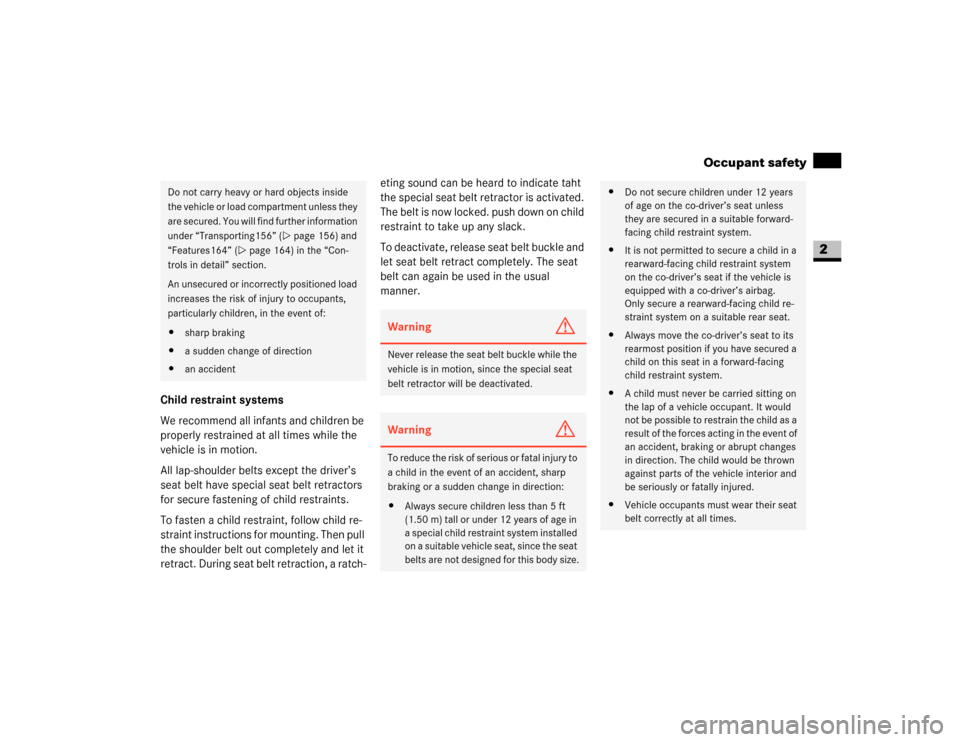
37 Safety
Occupant safety
2
Child restraint systems
We recommend all infants and children be
properly restrained at all times while the
vehicle is in motion.
All lap-shoulder belts except the driver’s
seat belt have special seat belt retractors
for secure fastening of child restraints.
To fasten a child restraint, follow child re-
straint instructions for mounting. Then pull
the shoulder belt out completely and let it
retract. During seat belt retraction, a ratch-eting sound can be heard to indicate taht
the special seat belt retractor is activated.
The belt is now locked. push down on child
restraint to take up any slack.
To deactivate, release seat belt buckle and
let seat belt retract completely. The seat
belt can again be used in the usual
manner.Do not carry heavy or hard objects inside
the vehicle or load compartment unless they
are secured. You will find further information
under “Transporting156” (\2page 156) and
“Features164” (\2page 164) in the “Con-
trols in detail” section.
An unsecured or incorrectly positioned load
increases the risk of injury to occupants,
particularly children, in the event of:
\4sharp braking
\4a sudden change of direction
\4an accident
Warning
G
Never release the seat belt buckle while the
vehicle is in motion, since the special seat
belt retractor will be deactivated.Warning
G
To reduce the risk of serious or fatal injury to
a child in the event of an accident, sharp
braking or a sudden change in direction:
\4Always secure children less than 5 ft
(1.50 m) tall or under 12 years of age in
a special child restraint system installed
on a suitable vehicle seat, since the seat
belts are not designed for this body size.
\4Do not secure children under 12 years
of age on the co-driver’s seat unless
they are secured in a suitable forward-
facing child restraint system.
\4It is not permitted to secure a child in a
rearward-facing child restraint system
on the co-driver’s seat if the vehicle is
equipped with a co-driver’s airbag.
Only secure a rearward-facing child re-
straint system on a suitable rear seat.
\4Always move the co-driver’s seat to its
rearmost position if you have secured a
child on this seat in a forward-facing
child restraint system.
\4A child must never be carried sitting on
the lap of a vehicle occupant. It would
not be possible to restrain the child as a
result of the forces acting in the event of
an accident, braking or abrupt changes
in direction. The child would be thrown
against parts of the vehicle interior and
be seriously or fatally injured.
\4Vehicle occupants must wear their seat
belt correctly at all times.
Page 39 of 393

38 SafetyOccupant safety
2
The use of infant or child restraints is re-
quired by law in all 50 states, the District
of Columbia, the U.S. territories and all Ca-
nadian provinces.
Infants and small children should be seat-
ed in an appropriate infant or child re-
straint system properly secured by a lap /
shoulder belt or, if so equipped, a top teth-
er anchorage point and a child restraint
lower anchorage system that complies
with U.S. Federal Motor Vehicle Safety
Standards 213 and 225 and Canadian Mo-
tor Vehicle Safety Standard 213 and
210.2.
Warning
G
If the child restraint system is not installed
correctly on a suitable vehicle seat, the child
may not be restrained in the event of an ac-
cident or sudden braking and may be seri-
ously or fatally injured. For this reason,
always observe the installation instructions
issued by the child restraint system manu-
facturer and the intended use for the child
restraint system when fitting it.
It is advisable to install the child restraint
system on one of the rear seats. The child is
generally better protected there.
Do not place objects (for example a cushion)
underneath the child restraint system. The
entire base of the child restraint system
must be in contact with the seat cushion at
all times.
Child restraint systems must not be used
without the original cover. Replace damaged
covers only with original covers.
On the rear seats, only use child restraint sys-
tems recommended by the manufacturer.
Warning
G
If you no longer require the child restraint sys-
tem, remove it from the vehicle or secure it
with the seat belt.
The restraint system could otherwise be
thrown through the vehicle interior in the
event of an accident.Warning
G
A child secured in a child restraint system
could be seriously or fatally injured in the
event of an accident, braking or a sudden
change in direction if the child restraint sys-
tem or its securing system is already dam-
aged or has been subjected to a load in an
accident.
Have restraint systems and their securing
systems which have been damaged or sub-
jected to a load in an accident checked and,
if necessary, replaced immediately at a
qualified specialist workshop which has the
necessary specialist knowledge and tools
for the work required.
The manufacturer recommends that you use
an authorized Sprinter Dealer for this pur-
pose. All work relevant to safety or on safe-
ty-related systems must be carried out at a
qualified specialist workshop.
Page 40 of 393
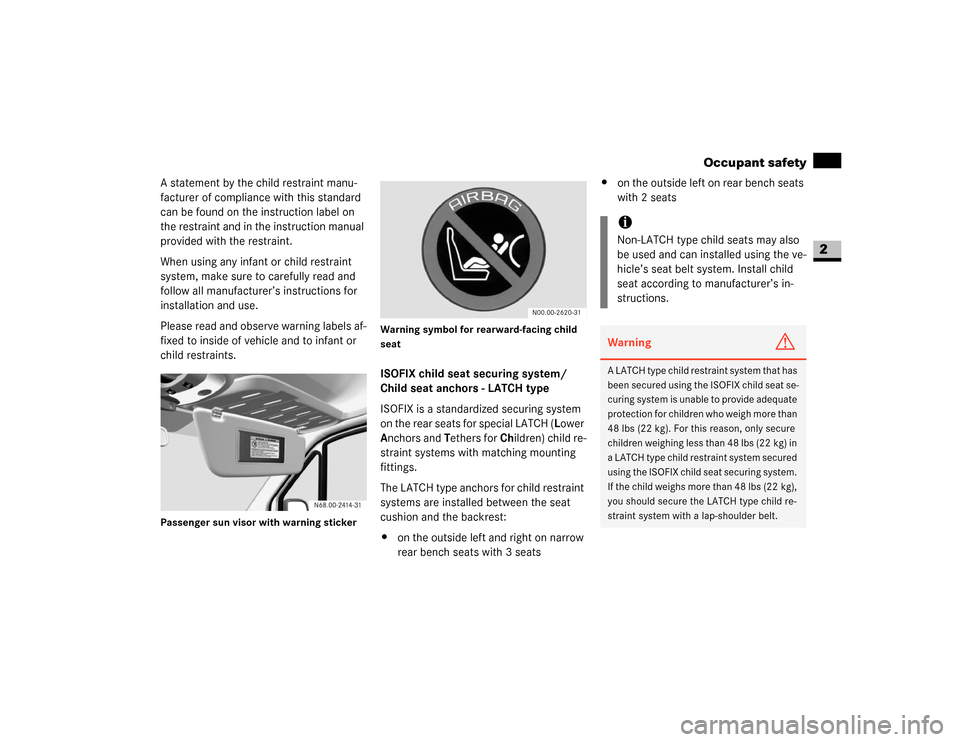
39 Safety
Occupant safety
2
A statement by the child restraint manu-
facturer of compliance with this standard
can be found on the instruction label on
the restraint and in the instruction manual
provided with the restraint.
When using any infant or child restraint
system, make sure to carefully read and
follow all manufacturer’s instructions for
installation and use.
Please read and observe warning labels af-
fixed to inside of vehicle and to infant or
child restraints.Passenger sun visor with warning stickerWarning symbol for rearward-facing child
seat
ISOFIX child seat securing system/
Child seat anchors - LATCH type
ISOFIX is a standardized securing system
on the rear seats for special LATCH (Lower
Anchors and Tethers for Children) child re-
straint systems with matching mounting
fittings.
The LATCH type anchors for child restraint
systems are installed between the seat
cushion and the backrest:
\4on the outside left and right on narrow
rear bench seats with 3 seats\4on the outside left on rear bench seats
with 2 seats
N00.00-2620-31
iNon-LATCH type child seats may also
be used and can installed using the ve-
hicle’s seat belt system. Install child
seat according to manufacturer’s in-
structions.Warning
G
A LATCH type child restraint system that has
been secured using the ISOFIX child seat se-
curing system is unable to provide adequate
protection for children who weigh more than
48 lbs (22 kg). For this reason, only secure
children weighing less than 48 lbs (22 kg) in
a LATCH type child restraint system secured
using the ISOFIX child seat securing system.
If the child weighs more than 48 lbs (22 kg),
you should secure the LATCH type child re-
straint system with a lap-shoulder belt.
Page 41 of 393
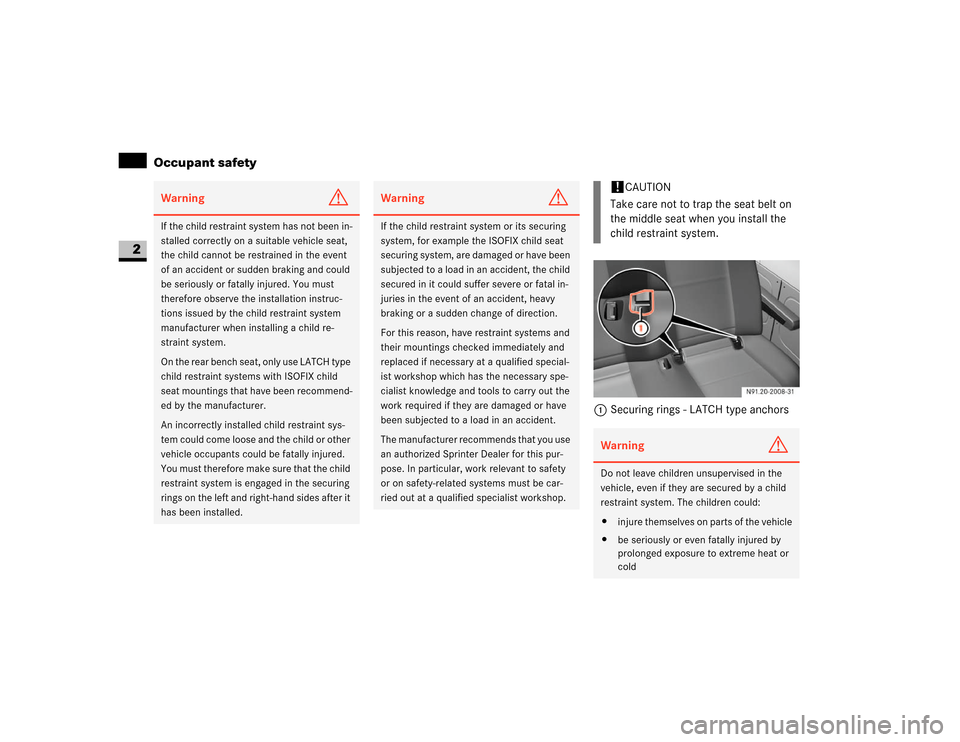
40 SafetyOccupant safety
2
1Securing rings - LATCH type anchors
Warning
G
If the child restraint system has not been in-
stalled correctly on a suitable vehicle seat,
the child cannot be restrained in the event
of an accident or sudden braking and could
be seriously or fatally injured. You must
therefore observe the installation instruc-
tions issued by the child restraint system
manufacturer when installing a child re-
straint system.
On the rear bench seat, only use LATCH type
child restraint systems with ISOFIX child
seat mountings that have been recommend-
ed by the manufacturer.
An incorrectly installed child restraint sys-
tem could come loose and the child or other
vehicle occupants could be fatally injured.
You must therefore make sure that the child
restraint system is engaged in the securing
rings on the left and right-hand sides after it
has been installed.
Warning
G
If the child restraint system or its securing
system, for example the ISOFIX child seat
securing system, are damaged or have been
subjected to a load in an accident, the child
secured in it could suffer severe or fatal in-
juries in the event of an accident, heavy
braking or a sudden change of direction.
For this reason, have restraint systems and
their mountings checked immediately and
replaced if necessary at a qualified special-
ist workshop which has the necessary spe-
cialist knowledge and tools to carry out the
work required if they are damaged or have
been subjected to a load in an accident.
The manufacturer recommends that you use
an authorized Sprinter Dealer for this pur-
pose. In particular, work relevant to safety
or on safety-related systems must be car-
ried out at a qualified specialist workshop.
!
CAUTION
Take care not to trap the seat belt on
the middle seat when you install the
child restraint system.
Warning
G
Do not leave children unsupervised in the
vehicle, even if they are secured by a child
restraint system. The children could:
\4injure themselves on parts of the vehicle
\4be seriously or even fatally injured by
prolonged exposure to extreme heat or
cold
Page 42 of 393
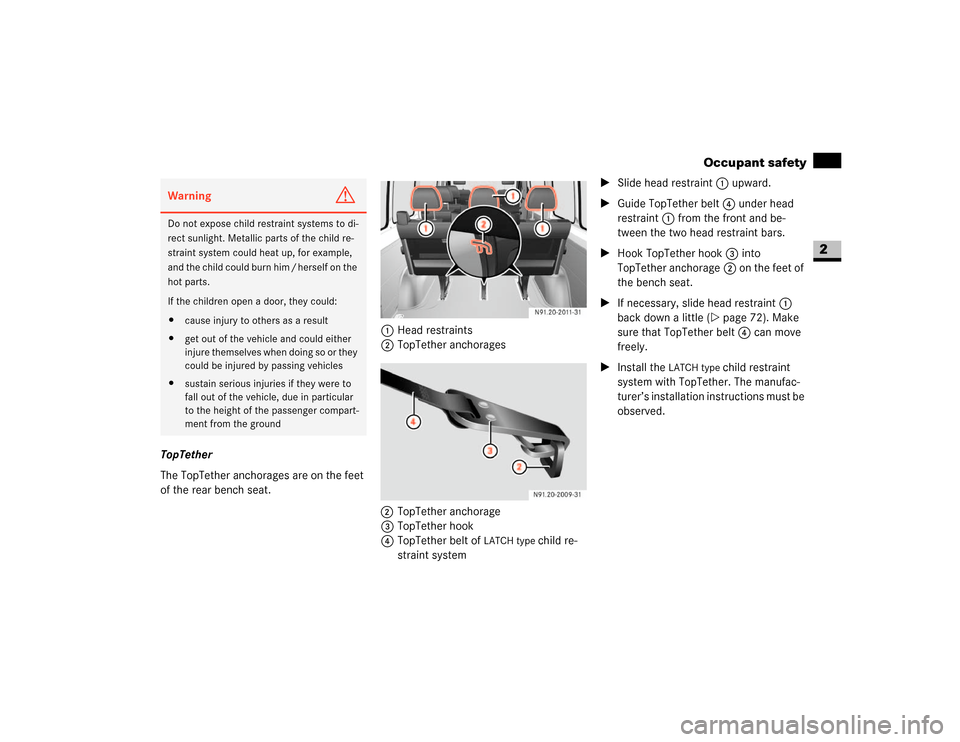
41 Safety
Occupant safety
2
TopTether
The TopTether anchorages are on the feet
of the rear bench seat.1Head restraints
2TopTether anchorages
2 TopTether anchorage
3TopTether hook
4TopTether belt of
LATCH type
child re-
straint system\1Slide head restraint1 upward.
\1Guide TopTether belt4 under head
restraint1 from the front and be-
tween the two head restraint bars.
\1Hook TopTether hook3 into
TopTether anchorage2 on the feet of
the bench seat.
\1If necessary, slide head restraint1
back down a little (\2page 72). Make
sure that TopTether belt4 can move
freely.
\1Install the
LATCH type
child restraint
system with TopTether. The manufac-
turer’s installation instructions must be
observed.
Warning
G
Do not expose child restraint systems to di-
rect sunlight. Metallic parts of the child re-
straint system could heat up, for example,
and the child could burn him / herself on the
hot parts.
If the children open a door, they could:
\4cause injury to others as a result
\4get out of the vehicle and could either
injure themselves when doing so or they
could be injured by passing vehicles
\4sustain serious injuries if they were to
fall out of the vehicle, due in particular
to the height of the passenger compart-
ment from the ground